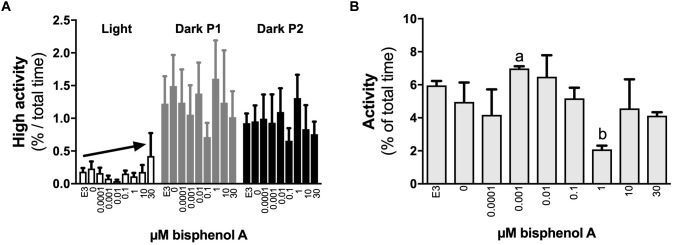FIGURE 2.
The effects of early developmental exposure to BPA on zebrafish embryo locomotor activity at 4 dpf. The amount of time (% of total) that 4 dpf zebrafish larvae were hyperactive (A) or active in general (B) when exposed to different light conditions after aqueous exposure to graded levels of BPA (0–30 μM) between 2 and 26 hpf. Light conditions in (A) were 5 min full light (open bars) followed by two sequential 5 min periods of darkness (dark P1 and P2, gray or black bars; see locomotor analysis variant 1 in methods). Light conditions in (B) were 1 s of dark (dark flash) followed by 9 s of full light, repeated three times (total of 30 s), and the data presented are the average responses over the 30 s period (see locomotor analysis variant 2 in methods). Solid arrows represent linear responses to increasing BPA exposure concentrations (p < 0.05, graph A, y = 0.12 + 0.01x, R2 = 0.17). Letters indicate statistical differences in mean values between treatments (one-way ANOVA, Tukey post hoc test, p < 0.05). Data are the mean ± SEM, n = 3, where each replicate is the average of 8–24 larvae.

